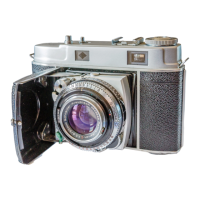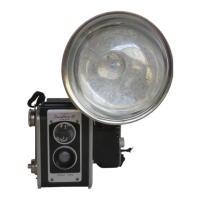f
"
The effect
of
a dissolve is
that
of
one scene appearing
to
melt i
nt
o
another.
What
really occurs is
that
one scene " fades-out" simul-
taneously
with
the "fading-in"
of
the
next scene. This overlapping
of
fades is made possible in the Cine-
Kodak
Special by the variable
shutter
and by
the
provision for
winding
the film backward.
The dissolve is made by
(1)
"fading
-
out;"
(2)
winding
back the
fi
lm;
(3)
"fading
-
in."
The fades must
be
made
as
described on page
45
.
Dissolves make a pleasing transition between allied scenes.
With
the Cine-
Kodak
Special, dissolves
of
any
length
can be made. Opinions
vary
as
to
the
proper length. Some contend
that
they
should roughly
match
the
tempo
of
the action,
while
others prefer a definite length for
all scenes.
For
average scenes, dissolv
es
a foot or
two
in
length
are effective ..
Until
experience is gained
in
timing, the following method is suggested
(refer
to
Figure
44
):
1.
As
you
begin a
"fade-out"
at
the end
of
the first scene, note the
CAMERA
FILM
METER
indication, or the FRAME COUNTER (see
page
50). .
2.
Gradually push SHUTTER LEVER as far
as
it
will
go beyond
CLOSED, using
two
feet
of
film for the complete movement.
3. Prepare to
wind
back
the
film by engaging
the
hand
crank on
the
EIGHT
-
FRAME
SHAFT and
holding
it
to prevent its turning; then-
4.
Watching
the METER,
hold
in
the
EXPOSURE BUTTON and
wind the film back
two
feet by
turning
the
crank
in
the direction
marked REVERSE, then release
the
EXPOSURE BUTTON.
Be
sure
the SHUTTER LEVER is
at
CLOSED.
5.
"Fade-in" on the next scene for
two
feet.
When
making
dissolves
with
the
camera adjusted
at
speed 16, where
it
is necessary for
the
operator to
watch
the subject,
the
shutter
can be
closed
whi
le counting a given number
of
seconds according to
the
length
of
the
dissolve. In rewinding the film,
two
reverse turns
of
the
EIGHT
-
FRAME
SHAFT must be made for each second
of
the "fade-
out." " Fade-
in"
for the same number
of
seconds
that
it
took
to
"fade-out."
It
takes about one second
to
pronounce " one hundred and
one;" a
little
practice
with
a
watch
will
make this procedure quite
simple.
47

